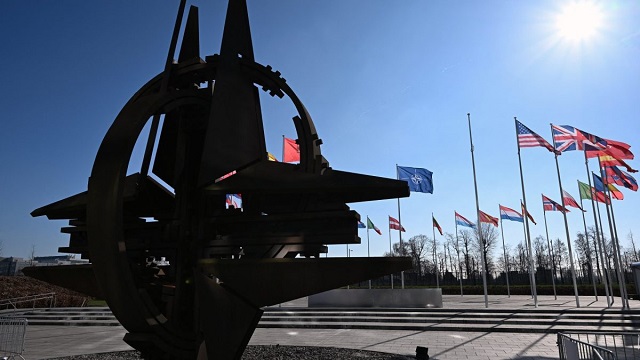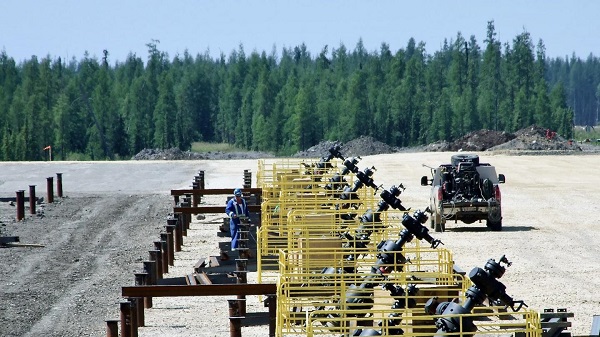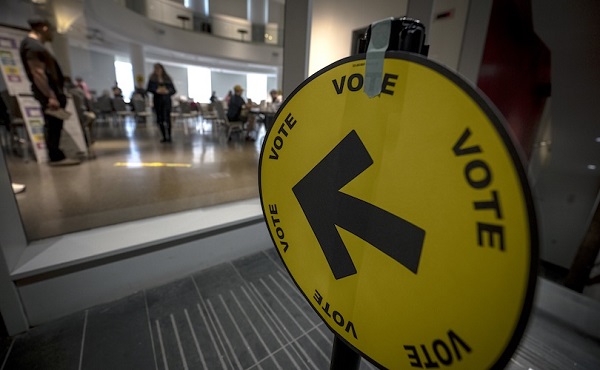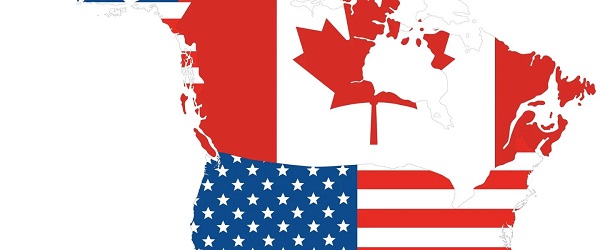Alberta
NATO reps say U.S., Canada oil and gas critical for energy security

Outside NATO headquarters ahead of a flag-raising ceremony for Sweden’s accession to NATO, in Brussels on February 27, 2024. Getty Images photo
From the Canadian Energy Centre
‘The traditional energy system will not disappear in a day’
Canada and the United States now produce more oil and gas than anywhere else on Earth, including the Middle East, according to a new report by S&P Global.
This blanket of energy security extends beyond borders and is “a powerful card to play” in increasingly unstable times, researchers wrote.
They found that without oil and gas produced in the U.S. and Canada – which has more than doubled since 2008 – North America, Europe and the rest of the world would have been “notably more vulnerable” following Russia’s invasion of Ukraine in 2022.
The ‘massive social impact’ of energy insecurity
Energy insecurity is all too familiar for Lithuanian Juljius Grubliauskas, who works for the North Atlantic Treaty Alliance (NATO).
Growing up, he was on hand when the Soviet Union weaponized energy in an attempt to topple Lithuania’s fledgling independence.
“I remember clearly from my childhood in 1990 when the Russians cut off energy supplies to try to break the resolve of the Lithuanians, [and] that affected the daily lives of every citizen,” Grubliauskas told a recent webinar hosted by the Toronto-based Institute for Peace and Diplomacy.
“Having a lack of energy has a massive social impact and massive cascading effects like prices immediately jumping, massive inflation and such,” he said.
“Today obviously many things have changed and the energy landscape looks much different, but the principle that energy is closely linked to national security and the independence of nations to make their decisions still remains true.”
North America’s role in NATO energy supply
Formed following the second world war, NATO represents 31 nations in Europe and North America in shared collective defense where an attack on one is seen as an attack on all.
NATO is finalizing a strategic plan for its energy future as the world seeks to reduce emissions, focusing primarily on secure access for military forces, Grubliauskas said.
Oil and gas from North America play a critical role, said Brussels-based NATO energy security policy expert Can Ögütcü.
“We need to be sure that we’re going to have security of supply of production in the U.S. and in Canada,” he said.
“We have last one import supplier, the Russians, [and] we are in the transition to perhaps also lose another big supplier, the Middle East Gulf countries, as maritime routes become more and more insecure.”
Critical North American energy integration
While Canadian oil and gas exports currently go almost exclusively to the U.S., once they enter the integrated pipeline system, they can become so-called “re-exports” from U.S. Gulf Coast to overseas markets.
At the end last year, the U.S. imported more oil from Canada than ever before, according to the U.S. Energy Information.
At the same time, America exported a record 11.5 million barrels per day of oil and petroleum products, and a record 709 billion cubic feet of natural gas.
“North American energy integration, things like the Enbridge Line 3 pipeline and the Keystone pipeline are absolutely crucial pieces of infrastructure, not just for the energy security of North America but also increasingly for the energy security of NATO allies,” said Joseph Calnan, energy security analyst with the Canadian Global Affairs Institute.
“The traditional energy system will not disappear in a day. Climate change of course makes it imperative that we do reduce our emissions globally but the role of Canada in the short term and medium term, I believe, is to firm up this traditional energy system.
“While Canada has a major role to play in future energy technologies, the current energy technologies are in my opinion, the priority.”
Canada can do more
Canada has not done enough to improve world energy security, said Heather Exner-Pirot, a senior fellow with the Macdonald-Laurier Institute.
“In the wake of Russia’s invasion, Canada has not stepped up and there is risk on all sides from depending too much on OPEC, or Qatar or Russia, but also too much on the United States,” she said, referencing the U.S. decision to pause approvals of new liquefied natural gas (LNG) export projects.
“We can do much more shipping on the East Coast. There are projects that were in the pipeline that have been rejected by the federal government and by provincial governments that could be going to Europe. Obviously on the West Coast is more promising.”
Major projects slated to start up soon like the Trans Mountain expansion and LNG Canada terminal will grow global access to Canadian oil and gas, primarily in the Indo Pacific region, Calnan noted.
“I think we’ll see that Canada has a much larger role to play in the total global market, which will have a stepwise influence on the situation in Europe,” he said.
Alberta
Petition threatens independent school funding in Alberta

From the Fraser Institute
Recently, amid the backdrop of a teacher strike, an Alberta high school teacher began collecting signatures for a petition to end government funding of independent schools in the province. If she gets enough people to sign—10 per cent of the number of Albertans who voted in the last provincial election—Elections Alberta will consider launching a referendum about the issue.
In other words, the critical funding many Alberta families rely on for their children’s educational needs may be in jeopardy.
In Alberta, the provincial government partially funds independent schools and charter schools. The Alberta Teachers’ Association (ATA), whose members are currently on strike, opposes government funding of independent and charter schools.
But kids are not one-size-fits-all, and schools should reflect that reality, particularly in light of today’s increasing classroom complexity where different kids have different needs. Unlike government-run public schools, independent schools and charter schools have the flexibility to innovate and find creative ways to help students thrive.
And things aren’t going very well for all kids or teachers in government-run pubic school classrooms. According to the ATA, 93 per cent of teachers report encountering some form of aggression or violence at school, most often from students. Additionally, 85 per cent of unionized teachers face an increase in cognitive, social/emotional and behavioural issues in their classrooms. In 2020, one-quarter of students in Edmonton’s government-run public schools were just learning English, and immigration to Canada—and Alberta especially—has exploded since then. It’s not easy to teach a classroom of kids where a significant proportion do not speak English, many have learning disabilities or exceptional needs, and a few have severe behavioural problems.
Not surprisingly, demand for independent schools in Alberta is growing because many of these schools are designed for students with special needs, Autism, severe learning disabilities and ADHD. Some independent schools cater to students just learning English while others offer cultural focuses, expanded outdoor time, gifted learning and much more.
Which takes us back to the new petition—yet the latest attempt to defund independent schools in Alberta.
Wealthy families will always have school choice. But if the Alberta government wants low-income and middle-class kids to have the ability to access schools that fit them, too, it’s crucial to maintain—or better yet, increase—its support for independent and charter schools.
Consider a fictional Alberta family: the Millers. Their daughter, Lucy, is struggling at her local government-run public school. Her reading is below grade level and she’s being bullied. It’s affecting her self-esteem, her sleep and her overall wellbeing. The Millers pay their taxes. They don’t take vacations, they rent, and they haven’t upgraded their cars in many years. They can’t afford to pay full tuition for Lucy to attend an independent school that offers the approach to education she needs to succeed. However, because the Alberta government partially funds independent schools—which essentially means a portion of the Miller family’s tax dollars follow Lucy to the school of their choice—they’re able to afford the tuition.
The familiar refrain from opponents is that taxpayers shouldn’t pay for independent school tuition. But in fact, if you’re concerned about taxpayers, you should encourage school choice. If Lucy attends a government-run public school, taxpayers pay 100 per cent of her education costs. But if she attends an independent or charter school, taxpayers only pay a portion of the costs while her parents pay the rest. That’s why research shows that school choice saves tax dollars.
If you’re a parent with a child in a government-run public school in Alberta, you now must deal with another teacher strike. If you have a child in an independent or charter school, however, it’s business as usual. If Albertans are ever asked to vote on whether or not to end government funding for independent schools, they should remember that students are the most important stakeholder in education. And providing parents more choices in education is the solution, not the problem.
Alberta
Busting five myths about the Alberta oil sands

Construction of an oil sands SAGD production well pad in northern Alberta. Photo supplied to the Canadian Energy Centre
From the Canadian Energy Centre
The facts about one of Canada’s biggest industries
Alberta’s oil sands sector is one of Canada’s most important industries — and also one of its most misunderstood.
Here are five common myths, and the facts behind them.
Myth: Oil sands emissions are unchecked

Steam generators at a SAGD oil sands production site in northern Alberta. Photo courtesy Cenovus Energy
Reality: Oil sands emissions are strictly regulated and monitored. Producers are making improvements through innovation and efficiency.
The sector’s average emissions per barrel – already on par with the average oil consumed in the United States, according to S&P Global – continue to go down.
The province reports that oil sands emissions per barrel declined by 26 per cent per barrel from 2012 to 2023. At the same time, production increased by 96 per cent.
Analysts with S&P Global call this a “structural change” for the industry where production growth is beginning to rise faster than emissions growth.
The firm continues to anticipate a decrease in total oil sands emissions within the next few years.
The Pathways Alliance — companies representing about 95 per cent of oil sands activity — aims to significantly cut emissions from production through a major carbon capture and storage (CCS) project and other innovations.
Myth: There is no demand for oil sands production

Expanded export capacity at the Trans Mountain Westridge Terminal. Photo courtesy Trans Mountain Corporation
Reality: Demand for Canadian oil – which primarily comes from the oil sands – is strong and rising.
Today, America imports more than 80 per cent more oil from Canada than it did in 2010, according to the U.S. Energy Information Administration (EIA).
New global customers also now have access to Canadian oil thanks to the opening of the Trans Mountain pipeline expansion in 2024.
Exports to countries outside the U.S. increased by 180 per cent since the project went into service, reaching a record 525,000 barrels per day in July 2025, according to the Canada Energy Regulator.
The world’s appetite for oil keeps growing — and it’s not stopping anytime soon.
According to the latest EIA projections, the world will consume about 120 million barrels per day of oil and petroleum liquids in 2050, up from about 104 million barrels per day today.
Myth: Oil sands projects cost too much
Reality: Operating oil sands projects deliver some of the lowest-cost oil in North America, according to Enverus Intelligence Research.
Unlike U.S. shale plays, oil sands production is a long-life, low-decline “manufacturing” process without the treadmill of ongoing investment in new drilling, according to BMO Capital Markets.
Vast oil sands reserves support mining projects with no drilling, and the standard SAGD drilling method involves about 60 per cent fewer wells than the average shale play, BMO says.
After initial investment, Enverus says oil sands projects typically break even at less than US$50 per barrel WTI.
Myth: Indigenous communities don’t support the oil sands

Chief Greg Desjarlais of Frog Lake First Nation signs an agreement in September 2022 whereby 23 First Nations and Métis communities in Alberta acquired an 11.57 per cent ownership interest in seven Enbridge-operated oil sands pipelines for approximately $1 billion. Photo courtesy Enbridge
Reality: Indigenous communities play an important role in the oil sands sector through community agreements, business contracts and, increasingly, project equity ownership.
Oil sands producers spent an average of $1.8 billion per year with 180 Indigenous-affiliated vendors between 2021 and 2023, according to the Canadian Association of Petroleum Producers.
Indigenous communities are now owners of key projects that support the oil sands, including Suncor Energy’s East Tank Farm (49 per cent owned by two communities); the Northern Courier pipeline system (14 per cent owned by eight communities); and the Athabasca Trunkline, seven operating Enbridge oil sands pipelines (~12 per cent owned by 23 communities).
These partnerships strengthen Indigenous communities with long-term revenue, helping build economic reconciliation.
Myth: Oil sands development only benefits people in Alberta
Reality: Oil sands development benefits Canadians across the country through reliable energy supply, jobs, taxes and government revenues that help pay for services like roads, schools and hospitals.
The sector has contributed approximately $1 trillion to the Canadian economy over the past 25 years, according to analysis by the Macdonald-Laurier Institute (MLI).
That reflects total direct spending — including capital investment, operating costs, taxes and royalties — not profits or dividends for shareholders.
More than 2,300 companies outside of Alberta have had direct business with the oilsands, including over 1,300 in Ontario and almost 600 in Quebec, MLI said.
Energy products are by far Canada’s largest export, representing $196 billion, or about one-quarter of Canada’s total trade in 2024, according to Statistics Canada.
Led by the oil sands, Canada’s energy sector directly or indirectly employs more than 445,000 people across the country, according to Natural Resources Canada.
-

 Alberta2 days ago
Alberta2 days agoClick here to help choose Alberta’s new licence plate design
-

 National2 days ago
National2 days agoDemocracy Watch Renews Push for Independent Prosecutor in SNC-Lavalin Case
-

 Business2 days ago
Business2 days agoOver two thirds of Canadians say Ottawa should reduce size of federal bureaucracy
-

 Alberta2 days ago
Alberta2 days agoBusting five myths about the Alberta oil sands
-

 Frontier Centre for Public Policy2 days ago
Frontier Centre for Public Policy2 days agoOttawa Should Think Twice Before Taxing Churches
-

 City of Red Deer1 day ago
City of Red Deer1 day agoPlan Ahead: Voting May Take a Little Longer This Election Day
-

 Business1 day ago
Business1 day agoUS government buys stakes in two Canadian mining companies
-

 Energy1 day ago
Energy1 day agoMinus Forty and the Myth of Easy Energy








